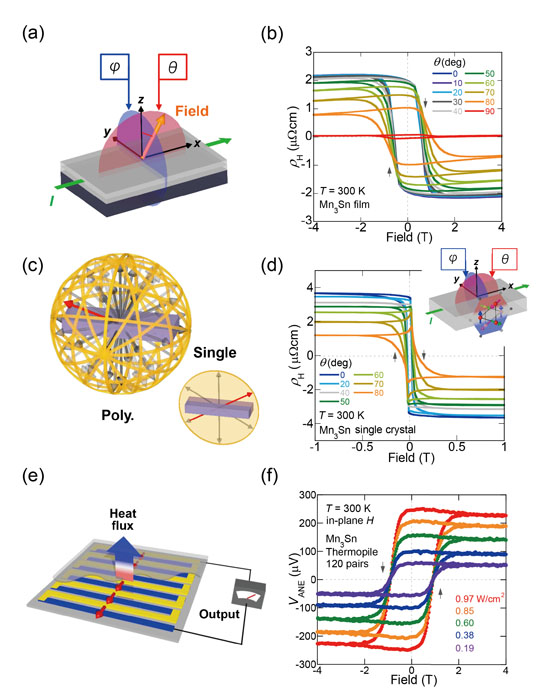Omnidirectional Control of Large Electrical Output in a Topological Antiferromagnet
Nakatsuji Group
The net magnetization defines the signal size of memory devices and sensors, and thus the manipulation of magnetization is essential for the broad application of ferromagnets. However, the magnetization itself causes a dilemma. While its size matters to obtain strong responses upon its reversal, the large magnetization simultaneously suppresses the range of its directional control due to the demagnetizing field. To overcome the demagnetization/shape barrier, one needs to carefully tune the crystalline and interfacial effects [1]. Thus, it would be ideal to find alternative magnets that carry no magnetization but strong responses.
The antiferromagnet Mn3Sn hosts a large Berry curvature in momentum space owing to the topological metallic state. The Berry curvature can be manipulated by the ferroic ordering of the cluster magnetic octupole and remains large even with negligible magnetization. This feature enables disproportionately large transverse responses such as anomalous Hall effect (AHE)[2] and anomalous Nernst effect (ANE)[3], opening up the possibilities for replacing ferromagnets with antiferromagnets in magnetic devices. As the first step for spintronics applications, we fabricated Mn3Sn thin films [4]. And more recently, we demonstrated electrical manipulation of the magnetic ordering in the Mn3Sn /heavy metal bilayer devices [5], which has triggered extensive research activities into the interface properties of Mn3Sn thin film.
In this study [6], we report the omnidirectional behavior in Mn3Sn due to negligible shape anisotropy. Moreover, we demonstrate a new method for multi-level data recording and a magnetically robust ANE-type heat flux sensor.
We have fabricated the polycrystalline Mn3Sn thin films on the thermally oxidized Si substrate by dc magnetron sputtering methods [4]. With these thin films, we measured the anomalous Hall effect as a function of magnetic field angles, θ and ϕ (Fig. 1(a)). As shown in Fig. 1(b), the field dependence of AHE obtained for various θ exhibits a multi-stable signal. Namely, the spontaneous Hall signal gradually decreases with increasing θ, indicating that the polarization direction of the magnetic octupole essentially follows the field direction rather than being restricted within the xy plane. Notably, the rotation for both θ and ϕ angles shows the same angular dependence, indicating that the magnetic octupole can be freely (omnidirectionally) orientated in all directions (Fig. 1(c)) as a result of the negligibly small shape anisotropy and polycrystalline arrangement.

Fig. 1. (a) Schematic illustration of the rotation planes. θ and φ are the angles from the normal direction within the planes parallel and perpendicular to the electric current direction, respectively. The orange arrow represents the direction of the external magnetic field. (b) Field dependence of the Hall resistivity obtained for the Mn3Sn film with various angles θ at 300 K. The black arrows indicate the field sweep direction. (c) Schematic illustrations ofthe 3D omnidirectional property for randomly oriented multi-grains and the 2D omnidirectional property for a single crystal/grain. The red arrow represents the direction of the magnetic order parameter. (d) Field dependence of the Hall resistivity obtained for the Mn3Sn single crystal with various angles θ at 300 K. Inset: Schematic illustrations of the rotation planes for the single crystal. (e) Schematic illustration of heat flux sensor. (f) Field dependence of the Nernst voltage VANE for the Mn3Sn thermopile made of 120 pairs of Mn3Sn/Au wires under several values of the heat flux qheater at 300 K.
Interestingly, single-crystal/grain samples also show the multi-stable signals as a function of the field angle, but only for field rotations within the kagome layer (Fig. 1(d)). Ferromagnets with magneto-crystalline anisotropy sufficiently larger than the shape anisotropy can show similar multi-stable behavior in their polycrystalline form. However, in the single crystal samples, the magnetization is restricted to one direction due to the substantial magneto-crystalline anisotropy, and therefore only a binary signal can occur. The new multi-level recording method found in Mn3Sn may allow writing and reading beyond two units of information (0 and 1), namely, a device comprising a single grain of nanometer scale can hold three or more units of information.
Taking advantage of the small shape anisotropy and the omnidirectional property, we developed a ANE heat flux sensor consisting of micro-fabricated Mn3Sn wires (Fig. 1(e)). This sensor exhibits the heat flux sensitivity comparable to that made of ferromagnetic materials while being resistant to magnetic field disturbances (Fig. 1(f)).
References
- [1] R. Skomski and J. M. D. Coey, Scr. Mater. 3, 112 (2016).
- [2] S. Nakatsuji et al., Nature 527, 212 (2015).
- [3] M. Ikhlas, T. Tomita et al., Nat. Phys. 13, 1085 (2017).
- [4] T. Higo et al., Appl. Phys. Lett. 113, 202402 (2018).
- [5] H. Tsai, T. Higo et al., Nature 608, 580 (2020).
- [6] T. Higo et al., Adv. Funct. Mater. 31, 2008971 (2021).
